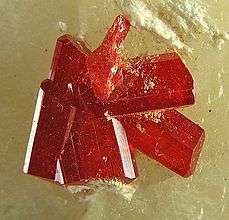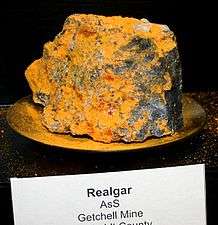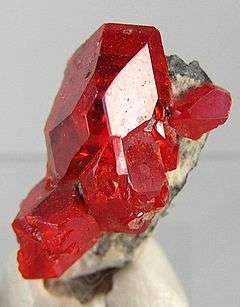Realgar
| Realgar | |
|---|---|
|
Realgar crystals, Royal Reward Mine, King County, Washington, US | |
| General | |
| Category | Sulfide mineral |
| Formula (repeating unit) | As4S4 or AsS |
| Strunz classification | 2.FA.15a |
| Crystal system | Monoclinic |
| Crystal class |
Prismatic (2/m) H-M symbol: (2/m) |
| Unit cell |
a = 9.325(3) Å b = 13.571(5) Å c = 6.587(3) Å β = 106.43°; Z = 16 |
| Identification | |
| Color | Red to yellow-orange; in polished section, pale gray, with abundant yellow to red internal reflections |
| Crystal habit | Prismatic striated crystals; more commonly massive, coarse to fine granular, or as incrustations |
| Twinning | Contact twins on {100} |
| Cleavage | Good on {010}; less so on {101}, {100}, {120}, and {110} |
| Tenacity | Sectile, slightly brittle |
| Mohs scale hardness | 1.5–2 |
| Luster | Resinous to greasy |
| Streak | Red-orange to red |
| Diaphaneity | Transparent |
| Specific gravity | 3.56 |
| Optical properties | Biaxial (-) |
| Refractive index |
nα = 2.538 nβ = 2.684 nγ = 2.704 |
| Birefringence | δ = 0.166 |
| Pleochroism | Nearly colorless to pale golden yellow |
| 2V angle | 40° |
| Dispersion | r > v, very strong |
| Other characteristics |
Toxic and carcinogenic. Disintegrates on long exposure to light to a powder composed of pararealgar or arsenolite and orpiment. |
| References | [1][2][3][4] |
Realgar, α-As4S4, is an arsenic sulfide mineral, also known as "ruby sulphur" or "ruby of arsenic". It is a soft, sectile mineral occurring in monoclinic crystals, or in granular, compact, or powdery form, often in association with the related mineral, orpiment (As2S3). It is orange-red in color, melts at 320 °C, and burns with a bluish flame releasing fumes of arsenic and sulfur. Realgar is soft with a Mohs hardness of 1.5 to 2 and has a specific gravity of 3.5. Its streak is orange colored. It is trimorphous with alacranite and pararealgar.[1] Its name comes from the Arabic rahj al-ġār (رهج الغار, "powder of the mine"), via Catalan and Medieval Latin, and its earliest record in English is in the 1390s.[5]
Occurrence
Realgar most commonly occurs as a low-temperature hydrothermal vein mineral associated with other arsenic and antimony minerals. It also occurs as volcanic sublimations and in hot spring deposits. It occurs in association with orpiment, arsenolite, calcite and barite.[1]
It is found with lead, silver and gold ores in Hungary, Bohemia and Saxony. In the US it occurs notably in Mercur, Utah; Manhattan, Nevada and in the geyser deposits of Yellowstone National Park.[4]
It is commonly held that after a long period of exposure to light realgar changes form to a yellow powder known as pararealgar (β-As4S4). It was once thought that this powder was the yellow sulfide orpiment, but has been recently shown to be a distinct chemical compound.
Uses
Realgar, orpiment, and arsenopyrite provide nearly all the world's supply of arsenic as a byproduct of smelting concentrates derived from these ores.
Realgar was used by firework manufacturers to create the color white in fireworks prior to the availability of powdered metals such as aluminium, magnesium and titanium. It is still used in combination with potassium chlorate to make a contact explosive known as "red explosive" for some types of torpedoes and other novelty exploding fireworks branded as 'cracker balls', as well in the cores of some types of crackling stars.
Realgar is toxic. The ancient Greeks, who called it "sandaracha", understood it is poisonous. It was used to poison rats in medieval Spain and in 16th century England.[6] It is still sometimes used to kill weeds, insects, and rodents,[7] even though more effective arsenic-based agents are available.
The Chinese name for realgar is xionghuang 雄黃, literally 'masculine yellow', as opposed to orpiment which was 'feminine yellow'. Its toxicity was also well known to them, and it was frequently sprinkled around houses to repel snakes and insects, as well as being used in Chinese medicine.[8] Realgar is mixed with rice liquor to make realgar wine, which is consumed during the Dragon Boat Festival in order to ward off evil, alluding to its repellent properties. (This practice has become rarer in modern times, with the awareness that realgar is a toxic arsenic compound.)
Realgar was commonly applied in leather manufacturing to remove the hair from animal pelts. Because realgar is a known carcinogen, and an arsenic poison, and because competitive substitutes are available, it is rarely used today for this purpose.
Realgar was, along with orpiment, a significant item of trade in the ancient Roman Empire and was used as a red paint pigment. Early occurrences of realgar as a red painting pigment are known for works of art from China, India, Central Asia, and Egypt. It was used in European fine-art painting during the Renaissance era, a use which died out by the 18th century.[9] It was also used as medicine.
Other traditional uses include manufacturing lead shot, printing and dyeing calico cloth.
Realgar gallery
-

Realgar, gemmy crystals on calcite, 8.9 x 6.9 x 3.6 cm. From Shimen County, Hunan Province, China
-
Realgar with tetrahedrite, Palomo Mine, Huancavelica Department, Perù
-

Realgar from Nagyag (Săcărâmb), Hungary (now Romania). Hand-colored copper-plate engraving by James Sowerby (1813)
-

On long exposure to light, realgar disintegrates into a reddish-yellow powder. Specimens should be protected from bright light.
-

The unit cell of realgar, showing clearly the As4S4 molecules it contains
See also
References
- 1 2 3 Handbook of Mineralogy
- ↑ Realgar at Mindat.org
- ↑ Realgar at Webmineral
- 1 2 Klein, Cornelis and Cornelius S. Hurlbut, Manual of Mineralogy, Wiley, 1985, 20th ed., p. 282 ISBN 0-471-80580-7
- ↑ Philip Babcock Grove, ed. (1993). Webster's Third New International Dictionary. Merriam-Webster, inc. ISBN 3-8290-5292-8.
- ↑ ref, ref (in French).
- ↑ See e.g. Hazardous Substance Factsheet for Realgar published by New Jersey Department of Environmental Protection (dated April 2008).
- ↑ On the toxicity of these medications
- ↑ Museum of Fine Arts, Boston
Further reading
- The Merck Index: An Encyclopedia of Chemicals, Drugs, and Biologicals. 11th Edition. Ed. Susan Budavari. Merck & Co., Inc., N.J., U.S.A. 1989.
- William Mesny. Mesny’s Chinese Miscellany. A Text Book of Notes on China and the Chinese. Shanghai. Vol. III, (1899), p. 251; Vol. IV, (1905), pp. 425–426.
- American Mineralogist Vol 80, pp 400–403, 1995
- American Mineralogist Vol 20, pp 1266–1274, 1992
External links
| Wikimedia Commons has media related to Realgar. |
